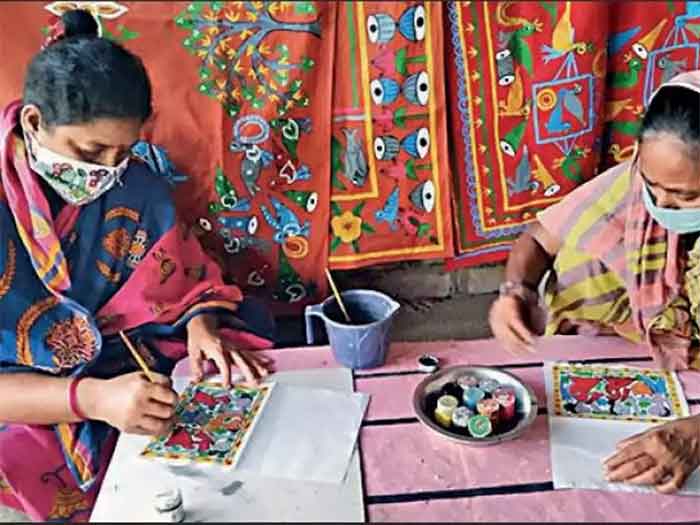
We are humans
Sons of one mother
One could be Hindu
One could be Muslim
The tribals call their god Gurung and Marung
The Christians call him God
The Muslims call him Allah
The Hindus call him Bhagwan
We are humans
Sons of one mother
Song of the Pata Chitrakars
His name could be Ajay or Azizul. Or, both. Yes, he can have two names. Two religions. Two identities. The main thing is his surname: Chitrakaar. Painter. Scroll-maker. Artist. Sculptor. Singer. Sutradhar of folk and mythical tales. Telling stories of Hindu gods and goddesses.
Across the beautiful rural landscape of West Bengal, especially in Midnapur, Bankura, Purulia, Murshidabad, 24 Parganas and Hooghly, they live in cloistered and humble homes, a bit shy and secluded, having suffered the worst during the two difficult years of the deadly pandemic and the lockdown. However, for them, the pandemic and the lockdown has been going on for a long, long time, trapped and condemned as they are in the deadly domain and arrogance of digitized modernity: mobiles, social media, Facebook, Instagram, television. Instant online gratifications.
So who cares a damn anymore or anyway for artists and painters who sing beautiful folk songs of the oral traditions, and who share a synthesis which transcends religion, caste, class or community, and, instead, celebrate the pure and magical art of painting and drawing, colours and kaleidoscopes, gods and goddesses, and the great secular pluralism of rural mythologies inherited from the past. So who will hear their songs anymore, and admire their painstaking paintings, drawn and coloured with such beauty, skill and creative passion over the years?
The patua chitrakars of Bengal shared one affinity with each other. The knack to tell a tale. On a scroll. Even when they tested the patience of the rural folk, travelling and wandering from village to village with their scrolls.
There is no action drama out here. No animation movie, or a comic strip in fast track. No titillating Tik Tok to hook you.
 This is a celebration of art and folk. As they hold up the scrolls out pours the plot of little known mythologies. Stories which have been inherited from the time and space of a secular synthesis of the past. Stories of love, life, motherhood, blessings, festivals, arrivals and departures. Their fingers move on the scrolls and their voice moves like an audio recording: the live bioscope of the sons of humans with one mother.
This is a celebration of art and folk. As they hold up the scrolls out pours the plot of little known mythologies. Stories which have been inherited from the time and space of a secular synthesis of the past. Stories of love, life, motherhood, blessings, festivals, arrivals and departures. Their fingers move on the scrolls and their voice moves like an audio recording: the live bioscope of the sons of humans with one mother.
Not anymore. The pandemic, lockdown and modernity have broken their back. They have no patrons or sympathizers anymore. It has become difficult to paint and draw, and survive. And, yet, they continue to live and love their scrolls.
There are coincidences in history. Their origin is stated to be around the 12th century, marking the rise of the Bhakti movement of secular sharing and the celebration of the religion of humanism. They are also linked to primordial tribal symbols as well as Islam and Buddhism. There are Sunni Muslims among them, but they also worship and follow Sufism.
Mostly Hindus, they were supposed to have been ostracized by the Brahmanical society because they refused to follow the clichéd and dogmatic stereotypes of religion and casteism, especially those practiced by the upper castes. They lived with flexibility, creativity, sensitivity – with a different take on religion.
For instance, they celebrate the religion of humanism. Muslim women artists will tell you without blinking, that, yes, icon worship is prohibited in Islam, but this is their art and craft, another form of religion, their everyday creative occupation. They would make idols, like their Hindu brothers and sisters, and draw and paint Hindu mythologies. They would also perform in Hindu festivals. Hence, they draw Hindu gods and goddesses and tell their stories. And, till day, no one seems to have objected across the sublime river shores and village bylanes of Bengal.
“We are persistent, despite the suffering. The pandemic months were extremely long and difficult. There were serious survival issues, but what we missed most was the joy of singing and telling stories, the joy of wandering from one village to another, the joy of sharing folk tales with simple village folks. We will hold on, come what may,” says a Patua chitrakaar, stoic and determined.
The scrolls they are making these days are full of rainbow colours and more. Vivid, vibrant and pulsating, they leap out of the sheets. It takes a long time to make a final and full scroll. The women have big eyes in the paintings, they are symmetrical and balanced, and even when they sing along in a rhythmic sing-song narrative, the pictures tell their own stories. Like the radio which helped people in distant and different geographies to take leaps of imagination, the beautiful scrolls are a key to open up the mind to magic and mythology, and celebrate the narratives of imagined tales.
In August, 2020, the ‘Hindu’ reported a magnificent flight of imagination, with the patuas, literally, experimenting with post-modern art, almost surreal in its depiction. Anwar Chitrakar in his 40s, inspired by the Kalighat school of painting, and very modern and spoofy in his adaptation of the art forms, depicted a family, their faces masked, dreaming of flying high. They fly over multi-storied high-rise buildings like angels, beautifully dressed in shining clothes. Dream World, these flights of imaginations are called: ‘Swopner Songshar’.
This was the artist’s way of breaking the condemnation and suffocation of Covid, the death and the dying, the helplessness and isolation. To turn adversity into a dream. In one painting, the birds and animals have come back to society to reclaim their space, while human beings have been put in cages. In another, cows become humans and humans become cows.
As Bengal comes back to normalcy, and as humans move out their cages, the chitrakars are again moving inside their scrolls with paint and brush, drawing stories which move from time and space, into the bitter and beautiful realities of everyday existence. It has been hard, but the narratives bring creative joy. It’s once again, a new mythology, a new folk tale, a new beginning yet again.
Amit Sengupta is Executive Editor, Hardnews and a columnist, currently based in Kolkata













































